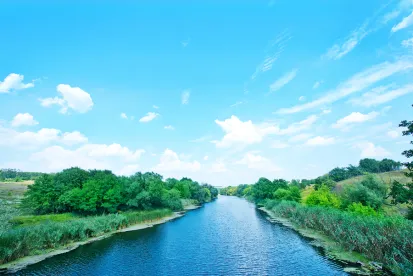On January 23, 2020, the United States Environmental Protection Agency (“EPA”) and the U.S. Army Corps of Engineers issued the Navigable Waters Protection Rule (the “2020 Rule”), which includes a revised definition of the “waters of the United States” subject to federal regulation under the Clean Water Act.[1] The revisions in the 2020 Rule come after a line of U.S. Supreme Court (“Supreme Court”) cases ending with Rapanos v. United States,[2] as well as an Obama-era administrative rule addressing the waterbodies under federal jurisdiction (the “2015 Rule”).[3] Rapanos was the last time the Supreme Court interpreted the term “waters of the United States,” with the intent of curtailing the substantial litigation concerning the meaning of the phrase and defining what “waters of the United States” should be included under federal jurisdiction. The 2015 Rule intended to clarify the definition further and codify the Supreme Court decisions. When effective, the newly issued Navigable Waters Protection Rule will limit the 2015 Rule, attempting again to define what are and what are not “waters of the United States.”
The controversy over how “waters of the United States” should be defined has persisted over decades since the passage of the Clean Water Act in 1972. Whether a property is found to contain regulated wetlands has a significant impact on how the land may be used or developed. Therefore, it is important that landowners and developers with potential wetlands on or adjacent to their properties understand the reach of this new federal regulation.
2015 Rule
The Clean Water Act, which regulates “navigable waters,” defines “navigable waters” simply as “waters of the United States, including territorial seas.”[4] In Rapanos, with plurality, concurring and dissenting opinions, all of the Justices concluded that “waters of the United States” include some waters that are not navigable in the traditional sense. The plurality found that “waters of the United States” included permanent and continuously flowing bodies of water (e.g., streams, oceans, rivers, and lakes), as well as only those wetlands with a “continuous surface connection” to a permanent body of water.[5] In his concurring opinion, Justice Kennedy was more inclusive and opined that for a wetland to be a jurisdictional water, there needed to be only a “significant nexus” to waters that are navigable.[6]
The 2015 Rule resulted in a broad definition of “waters of the United States.” The 2015 Rule placed waters into three categories to determine whether they are under the scope of the Clean Water Act: (1) waters that are covered by the Clean Water Act in all circumstances (known as “jurisdictional by rule”); (2) waters that require analysis on a case-by-case basis to see if the water is covered by the Clean Water Act; and (3) waters that are not covered by the Clean Water Act. Waters that are “jurisdictional by rule” are comprised of six categories that include waters that are used or could be used in interstate or foreign commerce, interstate waters, interstate wetlands, territorial seas, tributaries of the “jurisdictional by rule” waters, impoundments of water that are identified as jurisdictional, and waters adjacent to “jurisdiction by rule” waters, such as wetlands, lakes, and ponds.[7]
When looking at waters on a case-by-case basis, the 2015 Rule called for a determination of whether the water has a “significant nexus” to a jurisdictional water, i.e., whether a water or wetland affects the integrity of “jurisdictional by rule” waters, thereby incorporating Justice Kennedy’s definition. Waters that were not included were prior converted cropland, waste treatment systems, puddles, and swimming pools.[8]
2020 Rule
The 2020 Rule breaks down the “waters of the United States” into four categories that are narrower in scope than the 2015 Final Rule, following more closely the plurality opinion in Rapanos.[9] The four categories are (1) the territorial seas and traditional navigable waters; (2) tributaries of such waters; (3) lakes, ponds, and impoundments of jurisdictional waters; and (4) adjacent wetlands. The 2020 Rule also defines what are not “waters of the United States.”[10]
Under the 2020 Rule, jurisdictional waters include lakes, ponds, and impoundments only when they contribute surface water flow to a traditional navigable water or territorial sea directly, through other waters of the United States or through channelized non-jurisdictional surface waters. Lakes, ponds, and impoundments may also be regulated if they are flooded by a water of the United States in a “typical year.” Use of the typical year is to avoid the consideration of conditions that are too wet or too dry. Additionally, unlike the 2015 Rule, perennial and intermittent tributaries to traditional navigable waters are included within federal jurisdiction only if they flow more often than just after a single precipitation event.
Adjacent wetlands to be regulated under the 2020 Rule primarily include wetlands that actually touch other jurisdictional waters, although wetlands that are separated from a water of the United States by a natural berm, bank, dune, or artificial dike, are also considered regulated wetlands as in the 2015 Rule. Similar to lakes, ponds, and impoundments, an adjacent wetland may be under federal jurisdiction if it is inundated from the flooding of a water of the United States in a typical year. Waters that are not included in the Navigable Waters Protection Rule are waterbodies not included in the four categories, i.e., groundwater, ephemeral features, diffuse stormwater, farm and roadside ditches, and artificial lakes and ponds, among others.
The 2020 Rule eliminates the 2015 Rule’s “significant nexus” test, arguing that the 2015 Rule would allow for jurisdiction over waters that would conflict with Supreme Court precedent.[11] As a result of elimination of the significant nexus test, an important change in the 2020 Rule concerns contaminated groundwater that discharges into navigable waters. The 2015 Rule included such groundwater as jurisdictional. In the 2020 Rule, groundwater, including groundwater draining into navigable waters, is excluded from the definition of “waters of the United States.”[12] The regulation of contaminated groundwater would be left to other applicable Federal and State environmental statutes.*[13]
FOOTNOTES
[1] 33 U.S.C. §§1251 et seq. The 2020 Rule will be effective 60 days after the date of publication in the Federal Register. Find the provisions of the rule online.
[2] 547 U.S. 715 (2006); see also United States v, Riverside Bayview, 474 U.S. 121 (1985), Solid Waste Agency of N. Cook Cty., (SWANCC) v. U.S. Army Corps of Eng’rs, 531 U.S. 159 (2001).
[3] See 80 Fed. Reg. 37053 (June 29, 2015), codified at 40 CFR 230.3.
[4] 33 U.S.C. §1362(7).
[5] 547 U.S. at 742.
[6] Id. at 780 (“wetlands… [that] significantly affect the chemical, physical and biological integrity of other covered waters”). Although signing on to the plurality opinion, Chief Justice Roberts lamented in his own concurring opinion that, without a majority opinion, “[l]ower courts and regulated entities will now have to feel their way around on a case-by-case basis.” Id. at 758.
[7] 80 Fed. Reg. at 37058.
[8] Id. at 37098.
[9] The 2020 Rule followed Executive Order 13778, entitled “Restoring the Rule of Law, Federalism, and Economic Growth by Reviewing the ‘Waters of the United States’ Rule,” which called for a review and rescinding of the 2015 Rule, and promulgation of a new rule. See the full executive order.
[10] See the Original Document, at 87.
[11] Id. at 57.
[12] Id. at 8.
[13] E.g., the Comprehensive Environmental Response, Compensation and Liability Act, 42 U.S.C.§§9601 et seq., and State equivalents.
Ross Childs, an extern in Sheppard Mullin’s New York office, contributed to this article.



 />i
/>i
